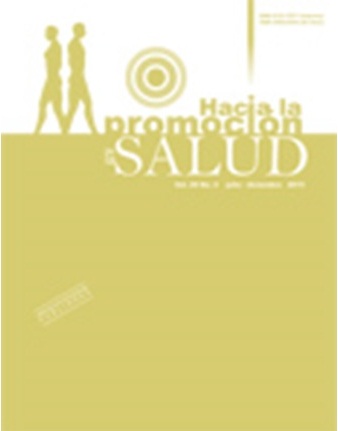Authors
Abstract
The article states the compelling need of health and educational institutions to work hand in hand to seek not only for the physical and psychological development of the students but for the social and spiritual ones as well; everything actively involved in the health promotion process by means of the implementation of several methodologies particularly the strategy of “Healthy Schools” which was positively assessed by the Organización Panamericana de la Salud (OPS). All this implementation must be based on the health education process, social interaction, strategic alliances, cooperation among all the different sectors involved, interdisciplinary work, and the establishment and strengthening of “networks” as outstanding tools for the whole process of Health Promotion in schools; every institution must take advantage of all these tools if they do want to get actively involved in the development of true and effective School Health programs which have to be fully integrated in the PEI (Institutional Educative Project). In such case the institutions are represented by the school and the community which is regarded by the Ley General de Educación (the General law of Education) ley 115/94 as the space and group where the student has the possibility to develop all his potentialities as well as to acquire a set of skills and competences which will eventually allow him to face the different challenges in life in a more effective way that definitely cannot be accomplished by itself, thus an interaction of the health field and educational institutions is compulsory to harmonically carry out all their actions in the school and make all of them go far beyond its sole duty which is basic health assistance. All of the above not only for the health but also for the educational field is completely supported on a legal and constitutional basis which is mainly established in the Political Constitution of Colombia in article 44 that states the fundamental rights of children, in addition to some local, national and international decrees, resolutions and declarations which are still expecting for integral projects to be increased and to show a better perspective for the future scholars as the upcoming citizens of the world and tomorrow. The article also states the responsibility of the University for the fostering of social forces that lead to a better formation of the childhood as the present and future of the world.
References
Congreso de la República de Colombia. Ley 115 de Educación Nacional. Febrero 8 de 1994.
Cubides Román, Carolina María; Morales Castaño, Olga Janeth; Restrepo Soto, Jaime Alberto. Sistematización de la experiencia “Desarrollo Humano y Habilidades para la vida en el proyecto Juventud Manizales 2000 y las instituciones asociadas al GIPA Manizales 1997-2002” CINDE - UNIVERSIDAD DE MANIZALES: MAESTRÍA EN EDUCACIÓN Y DESARROLLO HUMANO. Tesis de Grado. Manizales, Octubre de 2004.
Facultad de Enfermería, Universidad de la Sabana. Aplicación del Modelo de Adaptación en el ciclo vital humano. Bogotá: Universidad de la Sabana. 2003. ISBN 958-12-0224-2.
Fondo de las Naciones Unidas para la Infancia, UNICEF. Manual de Aplicación de la Convención de los Derechos del Niño. Preparado por Rachel Hodgkin y Peter Newel. Nueva York. 1998.
Grotberg, Edith. Guía de promoción de la resiliencia en los niños para fortalecer el espíritu humano. Fundación Bernard Van Leer, agosto 1996.
Gobernación de Caldas; Dirección Seccional de Salud de Caldas. Escuelas saludables: un escenario de calidad de educación. 2 edición. Manizales. 2002. Pág. 90.
Escuela Saludable: una herramienta para la paz. [En línea] [citado 8 de septiembre de 2006]. Disponible en http://www.col.ops-oomsrg/juventudes/ESCUELASALUDABLE/07presentacion.html.
López Yzuel, Chita. Cuidados enfermeros. Barcelona, masson, S.A. 2005. Isbn. 84-458-1414-1. pág. 27. Ministerio de Educación Nacional. Bogotá, Colombia. Decreto 1860 de 1994.
Ministerio de Salud, Bogotá. Resolución 412 de 2000 y Acuerdo 117 de 1998.
Muñoz Esparsa, Elsa. Escuela saludable: una estrategia para contribuir a elevar la calidad de vida de nuestros niños. [En línea] [Citado el 9 de septiembre 2006]. Disponible en http://www.encolombia.com/medicina/enfermeria/enfermeria5202-escuela.htm.
Organización Mundial de la Salud. Asociación canadiense de Salud Pública. Carta de Ottawa para la Promoción de la Salud. Canadá, noviembre de 1986. Pág. 4
Organización Mundial de la Salud. Ginebra. Estimulación de destrezas psicosociales en niños y adolescentes: proyecto habilidades para vivir. Traducción y resumen preparado por Leonardo Mantilla, ex jefe de la División de Desarrollo Humano, Ministerio de Salud de Colombia. Mayo de 1991.
Organización Mundial de la Salud. Quinta conferencia mundial de promoción de la salud. Hacia una mayor equidad, ciudad de México, junio de 2000.
Perea Quesada, Rogelia. Educación para la salud. Edit. Díaz de Santos. 2004.
Radda Barnen. Educación en salud: programa curricular y guía metodológica de educación inicial. Edaprospo, generación kallpa, Lima, Perú, 1993.
Restrepo, Jaime Alberto; Cano, Paula Alexandra y Gutiérrez, Andrea. Aproximación a la interpretación del sentido de las habilidades psicosociales y construcción de una propuesta en habilidades para vivir con un grupo de adolescentes de la Comuna 5 de la ciudad de Manizales. Universidad de Manizales. Facultad de Psicología. Línea de Investigación en Familia y Procesos de Identidad. Manizales. 1998.
Restrepo, Jaime Alberto; Ruiz, Sandra Juliana; Salazar, María Elena. Aproximación a la interpretación del sentido de las habilidades psicosociales y construcción de una propuesta parcial con el grupo de adolescentes E.S.E. Hospital Santa Mónica. Universidad de Manizales, Facultad de Psicología. Línea de Investigación Familia y Cultura, Sublínea de Adolescencia. Manizales, 1997.


 PDF (Español)
PDF (Español)
 FLIP
FLIP






















